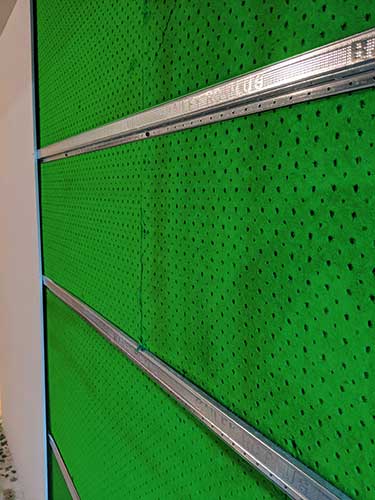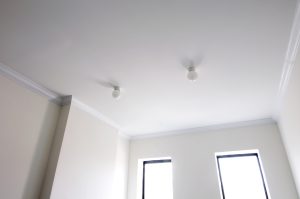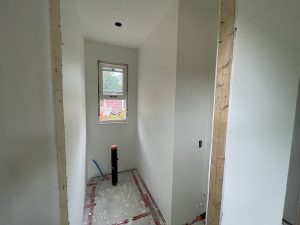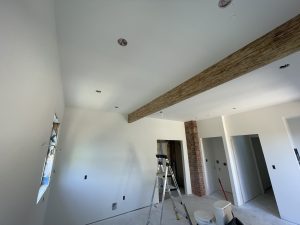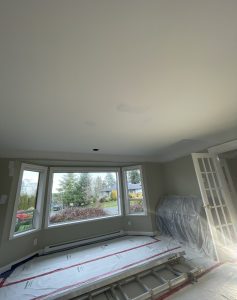As urbanization and open-concept designs continue to rise, noise management within homes has become more critical than ever. Many homeowners are increasingly aware of how noise affects daily comfort, productivity, and even property value. Whether it’s reducing street sounds, managing room-to-room noise, or creating a serene environment in bustling households, soundproofing drywall has become a go-to solution. For homeowners seeking quiet and private spaces, Finest Finish offers a range of science-backed drywall soundproofing solutions. In this guide, we’ll explore the technical side of soundproofing and how Finest Finish uses these insights to deliver quieter, more comfortable homes.
1. Understanding Sound Transmission: How Noise Travels
To understand soundproofing, it’s essential to know how sound moves through a home. Sound travels as waves and generally falls into two categories:
- Airborne Sound: This type of sound travels through the air, like voices, music, and appliances. Airborne sound passes easily through walls and open spaces, affecting privacy and causing disturbances in adjacent rooms.
- Structure-Borne Sound: Structure-borne sound, such as footsteps, appliance vibrations, or furniture movement, travels through physical materials like floors, walls, and ceilings. This type of sound is often harder to manage because it uses solid materials to carry noise across rooms.
By identifying the types of sound homeowners most want to control, Finest Finish tailors soundproofing strategies to reduce specific noise types for improved privacy and tranquility.
2. Key Metrics in Soundproofing: Decoding STC and NRC Ratings
Soundproofing is often measured using two key ratings: STC (Sound Transmission Class) and NRC (Noise Reduction Coefficient). Understanding these ratings helps homeowners make informed decisions about the best materials and solutions for their spaces.
- STC (Sound Transmission Class): This rating system measures a material’s ability to block airborne sound. The higher the STC rating, the better the material is at preventing sound from passing through it. For example, standard drywall has an STC rating of around 30-34, but specialized soundproof drywall can reach ratings over 50, making it much more effective in noise control.
- NRC (Noise Reduction Coefficient): This coefficient measures the amount of sound that is absorbed rather than reflected by a material within a space. Materials with high NRC ratings are effective at reducing echoes and reverberations within a room, making it quieter and more pleasant.
At Finest Finish, we carefully select materials with optimal STC and NRC ratings to ensure comprehensive soundproofing. By combining high-STC drywall with materials that absorb sound internally, we can achieve excellent noise reduction and enhanced acoustic comfort.
3. Types of Drywall for Soundproofing: Selecting the Right Material
Drywall plays a major role in soundproofing. Different types of drywall are available, each with its own soundproofing potential:
- Standard Drywall: While standard drywall is affordable and common, its soundproofing abilities are limited. With an STC rating of around 30, it’s not ideal for spaces requiring high noise reduction.
- Soundproof Drywall: This type of drywall is specifically engineered for soundproofing. It includes a denser core, often with added mass or a damping layer, to absorb and block sound more effectively. Soundproof drywall typically has an STC rating of 50 or higher.
- Double-Layer Drywall Systems: Adding a second layer of drywall can significantly improve soundproofing by increasing mass. Finest Finish can apply this technique in spaces where maximum soundproofing is needed, such as home theaters, bedrooms, or offices.
Finest Finish understands that each project is unique and recommends the ideal drywall type based on each client’s specific soundproofing needs, ensuring both performance and cost-effectiveness.
4. Soundproofing Techniques: Creating a Barrier Against Noise
Effective soundproofing goes beyond drywall type. Several installation techniques can greatly enhance the noise-reduction capabilities of drywall.
- Resilient Channel Installation: Resilient channels are metal strips installed between drywall and framing. They create a gap that decouples the drywall from the structure, which reduces the amount of sound that can pass through.
- Damping Compounds: Finest Finish often uses damping compounds like Green Glue between drywall layers. These compounds absorb sound vibrations and convert them into minimal heat, which prevents sound from traveling through walls.
- Decoupling and Isolation: Decoupling involves separating one layer of material from another, which can help prevent structure-borne noise. Decoupling techniques are especially valuable for ceilings and walls that require high sound insulation.
- Insulation and Barrier Materials: High-density insulation materials, such as mineral wool, are essential in soundproofing walls and ceilings. By filling cavities with sound-absorbing insulation, Finest Finish enhances the STC rating of walls without affecting room aesthetics.
Through a strategic combination of these techniques, Finest Finish ensures comprehensive soundproofing that addresses both airborne and structure-borne noise.
5. Steps in the Soundproofing Drywall Installation Process
Creating a truly soundproofed room requires a meticulous approach. Here’s an overview of the typical process used by Finest Finish:
- Planning for Soundproofing: Finest Finish begins by evaluating the home’s noise control needs. We assess which rooms require soundproofing, the type of noise to be managed, and any design preferences.
- Material Selection and Procurement: Based on the noise assessment, Finest Finish selects materials with optimal STC and NRC ratings, like soundproof drywall, resilient channels, and high-density insulation.
- Installation and Finishing: Our skilled installers use advanced soundproofing techniques, including resilient channel installation, decoupling, and damping compounds, to create a seamless, quiet finish.
- Quality Control: Finest Finish ensures each layer is installed according to high standards, verifying soundproofing effectiveness with specialized testing equipment to meet the client’s expectations for noise control.
6. Benefits of Soundproofing in Residential Spaces
The advantages of soundproofing extend beyond just noise reduction. Effective soundproofing offers several key benefits:
- Enhanced Privacy: Soundproofing keeps conversations private between rooms, which is especially beneficial in open-concept homes, bedrooms, and offices.
- Improved Comfort: A quieter home is more relaxing and enjoyable. Soundproofing helps to create an oasis of calm, even in busy neighborhoods.
- Higher Home Value: Homes with soundproofing often have higher property values as this feature is desirable in the high-end real estate market.
- Energy Efficiency: Certain soundproofing materials also provide thermal insulation, which can enhance energy efficiency and potentially lower heating and cooling costs.
Soundproofing drywall installation by Finest Finish not only improves comfort but can also add value and efficiency to a property, making it an excellent investment.
7. Challenges in Soundproofing Drywall Installation
While soundproofing offers many benefits, it can present some challenges:
- Balancing Aesthetics and Performance: Incorporating soundproofing materials without disrupting design aesthetics is key. Finest Finish integrates materials in ways that maintain the elegance of each room.
- Space Constraints: Soundproof drywall often requires added thickness, which may be a challenge in tighter spaces. Finest Finish considers room layout and available space to provide optimal solutions.
- Cost Considerations: High-performance soundproofing materials and techniques can add to the cost of a project. However, the investment yields lasting comfort and quality, making it worthwhile for clients seeking long-term solutions.
Through experience and creativity, Finest Finish addresses these challenges to provide the highest level of soundproofing without compromising design or budget.
8. Real-World Examples: Success Stories by Finest Finish
At Finest Finish, we’re proud to have transformed many homes into peaceful retreats. Here are some examples:
- Home Theater in a Family Home: We installed double-layer soundproof drywall with Green Glue in the theater room of a busy family’s home, achieving a high STC rating and providing a cinema-quality experience without disturbing others.
- Quiet Home Office: For a remote worker, we implemented resilient channels and mineral wool insulation to soundproof a home office, reducing noise distractions and boosting productivity.
These examples showcase how custom soundproofing solutions from Finest Finish create tranquil spaces that meet the specific needs of each client.
9. Maintenance Tips for Soundproofed Drywall
Soundproofed drywall requires minimal maintenance, but a few steps can help it stay effective:
- Regular Inspections: Occasionally check resilient channels and drywall for signs of wear.
- Moisture and Mold Control: Ensure good ventilation and moisture control in soundproofed areas to prevent damage.
- Upgrades: As new soundproofing technology becomes available, Finest Finish can provide assessments and recommend upgrades.
Conclusion: Why Choose Finest Finish for Soundproofing Drywall?
Soundproofing is an invaluable investment for homeowners who value privacy, comfort, and property value. With our expertise in drywall installation and soundproofing, Finest Finish is committed to creating peaceful, high-quality living environments tailored to each client’s needs. Reach out to learn more about how Finest Finish can help transform your home into a serene retreat with our science-backed soundproofing solutions.

